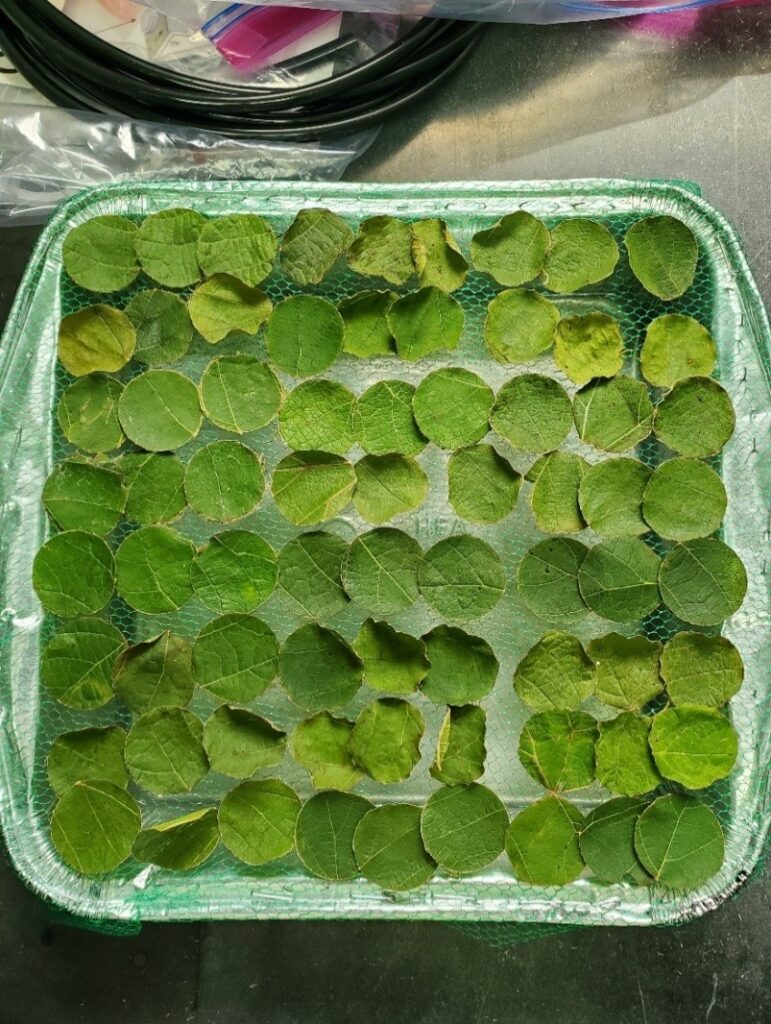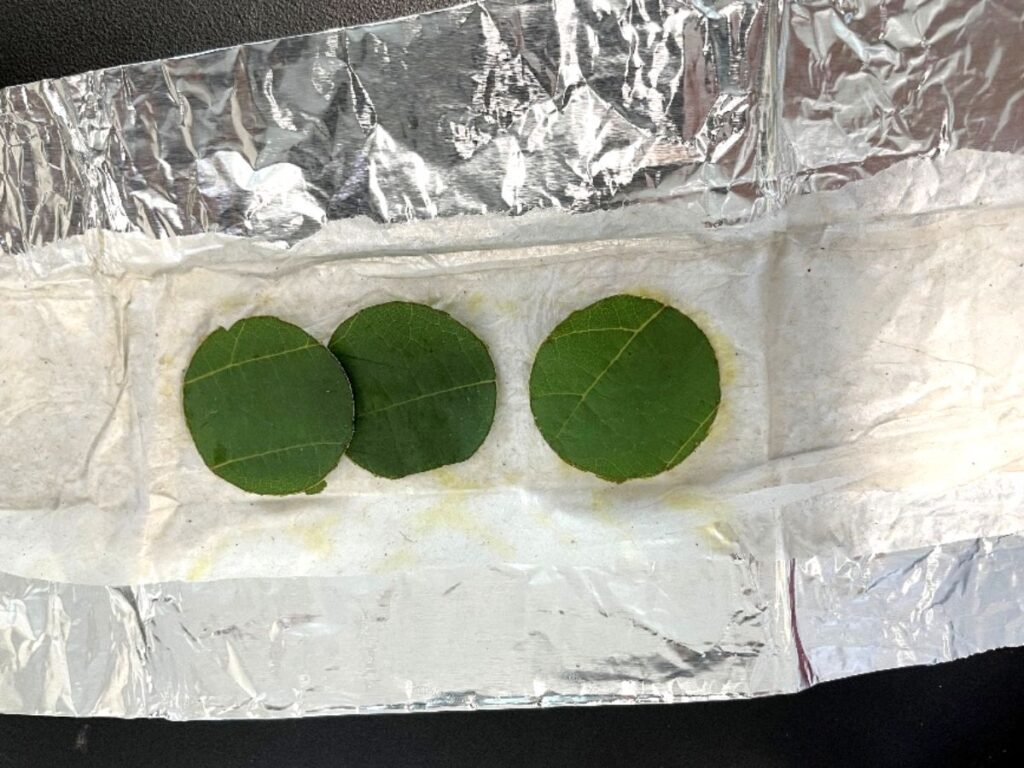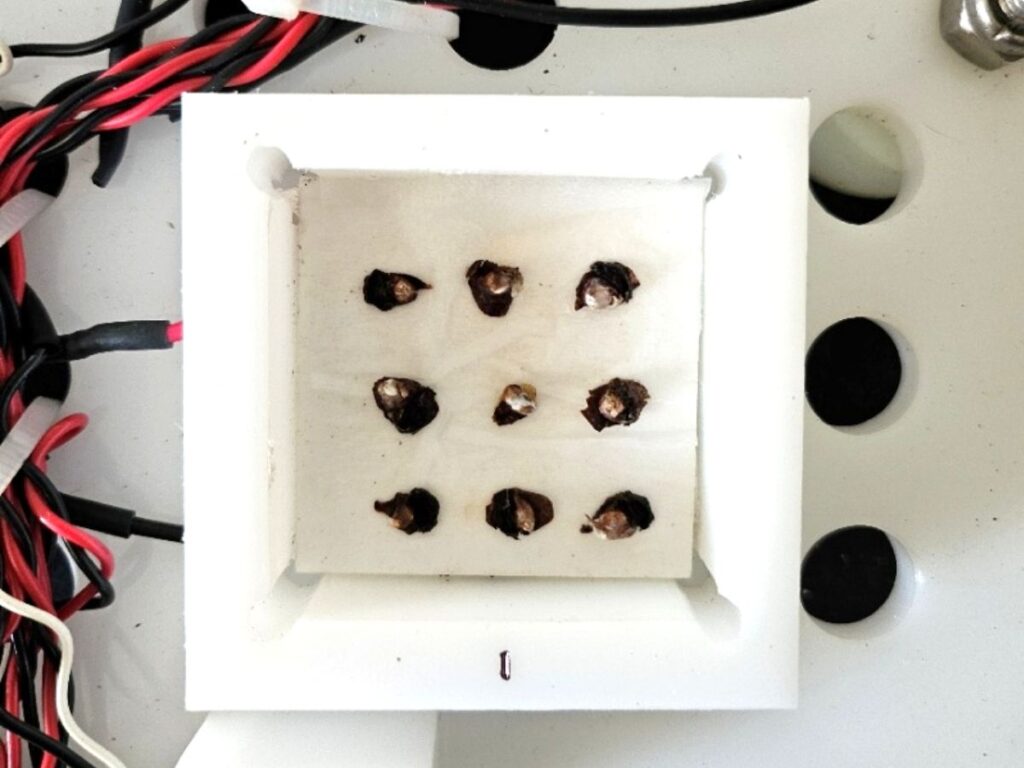Haley N. Williams and Eric T. Stafne, Mississippi State University
There is a clear interest from local growers and winemakers in expanding the production of bunch grapes in the Gulf South region. High quality production is low due to high disease and climate pressures. Hence, there is a need to explore which grape cultivars are best suited to the region.
Table of Contents
Challenges in Cultivar Selection
One of the biggest obstacles to growing grapes in this region is Pierce’s disease (PD), which is especially detrimental to traditional European wine grapes (Vitis vinifera). Thus, the industry has relied on PD-tolerant cultivars that were bred in the South, but they don’t always offer the best wine quality or yields. Recently, new cultivars, such as ‘Ambulo Blanc’, have been released by breeding programs in California. These grapes show promise because they combine PD resistance with a high percentage of V. vinifera, offering better wine quality and productivity. However, we don’t yet know how these new cultivars will hold up to our subtropical climate.
Cultivar Climate Resilience
Southern grape cultivars may be better adapted to subtropical conditions. However, more frequent extreme weather events, such as drought, heat waves, and spring frosts, pose major challenges to grape production, affecting vine physiology and resultant fruit production. It should be noted that grapevines are generally more resilient to drought than other crops, as discussed by Gambetta et al. (2020). However, a great deal of variation in stress tolerance exists among cultivars, and it is unclear whether this variation is primarily due to genetic differences or environmental influences. Thus, our goal is to identify cultivars that can best tolerate drought, heat, and cold as well as the already difficult climate of the Gulf South.
Study Design
In 2023, a study took place at the Mississippi State University South Mississippi Branch Experiment Station in Poplarville, MS, to evaluate drought, heat, and cold stress responses in nine bunch grape cultivars: ‘Ambulo Blanc’, ‘Black Spanish’, ‘Blanc du Bois’, ‘Lomanto’, ‘Mamont Noir’, ‘MidSouth’, ‘Miss Blanc’, ‘Muench’, and ‘Victoria Red’. Many of these vines were planted in 2022 and are maintained under drip irrigation. From May to September, field measurements included environmental conditions (temperature, precipitation, humidity, solar radiation, growing degree days, and chill hours), which were collected from a weather station located within 700 feet of the majority of the vines included in the study, and vine physiological measurements (stomatal conductance, transpiration, vapor pressure deficit, and chlorophyll fluorescence), which were collected using a LI-600 porometer/fluorometer (Table 1).
Table 1
Definitions and stress responses of key plant physiological traits measured in this study.
| Term | Definition | Stress Response |
|---|---|---|
| Stomatal Conductance | The rate at which gases pass through stomata (leaf pores) | Decreases under drought stress to reduce transpiration, increases under heat stress to induce transpiration |
| Transpiration | The release of water vapor through stomata | Decreases under drought stress to conserve water, increases under heat stress to allow for evaporative cooling |
| Vapor Pressure Deficit | The difference between the moisture in the air and how much moisture the air can hold at a given temperature | Increases under heat and low humidity, drives higher transpiration if stomata remain open |
| Chlorophyll Fluorescence | The light emitted by chlorophyll during photosynthesis | Decreases under stress due to damage to photosystem II |
| Electrolyte Leakage | A measure of cell membrane damage | Increases under stress, especially heat |
Laboratory tests on 1 inch leaf disks simulated drought and heat to assess water loss, electrolyte leakage, and other physiological measurements (Table 1). Leaves were collected from the field, and then leaf disks were cut out prior to undergoing stress treatments. For drought simulation, disks were placed on a custom mesh platform suspended over a saltwater solution inside a foil container (Figure 1). The container was sealed and placed in a growth chamber set to 80.6°F, 85% relative humidity, and 200 µmol/m²s lighting for 4 hours, with disks being weighed every hour to determine water loss. For heat simulation, leaf disks were wrapped in damp paper towels, enclosed in foil, and incubated in a growth chamber programmed to increase from 77°F to 113°F over 4 hours at constant 85% relative humidity and 200 µmol/m²s lighting, with electrolyte leakage being measured every 2 hours with a conductivity meter (Figure 2).


To assess cold tolerance, differential thermal analysis was conducted on dormant buds from December 2023 to February 2024. The dormant buds were collected from the field, and then nine buds of one cultivar were placed in individuals wells of a tray (Figure 3). Each well was positioned on a thermoelectric module designed to detect low temperature exotherms, representing the lethal temperatures (LT) to the buds. The buds were then subjected to a freezing program in a chamber that gradually cooled from 39.2°F to -40°F. This process allowed for the determination of average LT, as well as the LT corresponding to 10%, 50%, and 90% bud mortality.

Weather Overview
Monthly weather data revealed August as the hottest and driest month, with peak temperatures, solar radiation, and growing degree days, along with minimal rainfall, humidity, and chill hours. January, on the other hand, had the lowest temperatures and growing degree days and highest rainfall and chill hours (Table 2).
Table 2
Average temperature, humidity, and solar radiation and cumulative precipitation, growing degree days, and chill hours within each month of the conducted study from May 2023 – February 2024 in Poplarville, MS.
| Month | Average Temperature in °F (°C) | Total Precipitation in inches (cm) | Average Relative Humidity (%) | Average Solar Radiation (Langley’s) | Total Growing Degree Days in °F, base 50°F (base 10°C) | Total Chill Hours (<45°F or <7.2°C) |
|---|---|---|---|---|---|---|
| May | 74.8 (23.8) | 5.2 (13.3) | 73.9 | 507.5 | 769 (427) | 0 |
| June | 80.6 (27.0) | 3.9 (9.9) | 75.2 | 519.6 | 920 (511) | 0 |
| July | 83.8 (28.8) | 3.1 (7.8) | 74.3 | 508.5 | 1046 (581) | 0 |
| August | 88.2 (31.2) | 0.0 (0.0) | 65.3 | 535.9 | 1181 (656) | 0 |
| September | 81.0 (27.2) | 1.4 (3.5) | 68.6 | 422.8 | 927 (515) | 0 |
| October | 68.5 (20.3) | 2.2 (5.5) | 70.5 | 346.9 | 576 (320) | 0 |
| November | 59.0 (15.0) | 1.5 (3.8) | 74.4 | 233.9 | 281 (156) | 106 |
| December | 54.1 (12.3) | 5.8 (14.8) | 70.0 | 237.3 | 166 (92) | 178 |
| January | 49.3 (9.6) | 12.0 (30.5) | 71.5 | 238.9 | 106 (59) | 294 |
| February | 57.7 (14.3) | 2.3 (5.9) | 66.9 | 297.4 | 236 (131) | 111 |
Field Evaluation Results
During field evaluations, cultivar responses to environmental conditions varied most in August. ‘Ambulo Blanc’ showed high rates of stomatal conductance and transpiration (T) combined with low vapor pressure deficit (VPD), indicating efficient self-cooling, but likely at the cost of water use. In contrast, ‘Mamont Noir’ and ‘Lomanto’ had low T, favoring drought tolerance. ‘Muench’ exhibited the highest VPD, suggesting limited evaporative cooling but higher water conservation. Chlorophyll fluorescence was highest in ‘Lomanto’ and lowest in ‘Miss Blanc’, reflecting differences in resilience and indicating that ‘Miss Blanc’ was less photosynthetically active than ‘Lomanto’ in response to their environmental stressors (Table 3).
Drought Tolerance Results
Under drought simulation conditions, water loss increased linearly for all cultivars, but the overall rate of water loss declined in the later months that were hotter and drier, suggesting some form of vine adaptation. Stomatal conductance (SC) and transpiration (T) patterns closely aligned, with ‘Lomanto’ and ‘Black Spanish’ showing the highest rates, while ‘Victoria Red’ and ‘Mamont Noir’ generally maintained lower rates, indicating less water use. Chlorophyll fluoresence (CF) declined across all cultivars, but ‘Mamont Noir’ maintained the highest rates overall. The combination of low SC and T with high CF highlights ‘Mamont Noir’ as the most drought-resilient cultivar evaluated, while high SC and T in ‘Lomanto’ and ‘Black Spanish’ suggest greater susceptibility (Table 3).
Heat Tolerance Results
Under heat simulation conditions, electrolyte leakage remained stable across all months except August, when ‘Muench’ displayed significantly higher rates of leakage, indicating greater cell membrane damage. Transpiration (T) was highest in ‘Lomanto’ and lowest in ‘Mamont Noir’. Chlorophyll fluorescence (CF) declined sharply at the end of each simulation, with ‘Ambulo Blanc’ consistently showing the lowest CF while ‘Black Spanish’ maintained the highest. Based on high T and CF, ‘Lomanto’ and ‘Black Spanish’ appeared most heat tolerant, while ‘Muench’, ‘Mamont Noir’, and ‘Ambulo Blanc’ showed the greatest sensitivity to heat stress among our tested grapevine cultivars (Table 3).
Table 3
Summary of significant key physiological traits (stomatal conductance [SC], transpiration [T], vapor pressure deficit [VPD], chlorophyll fluorescence [CF], electrolyte leakage [EL]) observed in cultivars under 2023 field, drought, and heat conditions in comparison with each other.
| Cultivar | Field | Drought | Heat | Drought/Heat Tolerance Prediction |
|---|---|---|---|---|
| Ambulo Blanc | ↑ SC and T ↓ VPD | Neutral | ↓ CF | Less heat tolerant |
| Black Spanish | Neutral | ↑ SC and T | ↑ CF | Less drought tolerant More heat tolerant |
| Blanc du Bois | Neutral | Neutral | Neutral | Moderate drought and heat tolerance |
| Lomanto | ↓ T ↑ CF | ↑ SC and T | ↑ T | Less drought tolerant More heat tolerant |
| Mamont Noir | ↓ T | ↓ SC and T ↑ CF | ↓ T | More drought tolerant Less heat tolerant |
| MidSouth | Neutral | Neutral | Neutral | Moderate drought and heat tolerance |
| Miss Blanc | ↓ CF | Neutral | Neutral | Moderate drought and heat tolerance |
| Muench | ↑ VPD | Neutral | ↑ EL | Less heat tolerant |
| Victoria Red | Neutral | ↓ SC and T | Neutral | More drought tolerant |
Cold Tolerance Results
Lethal temperatures (LT) at which 10%, 50%, and 90% bud mortality occurred varied by month. Buds collected in December were the least cold-hardy, with mean LT values of 9.3°F, while increased tolerance was observed in January at -1.8°F and February at 3.2°F (Table 4). Additionally, the lowest LT, at which 90% bud mortality occurred, was -9.6°F in January when the average temperature and cumulative chill hours were 49.3°F and 294, respectively (Table 2 and 4), with the lowest recorded temperature of 14°F. This pattern reflects increasing bud cold hardiness as more chill hours accumulate, indicating seasonal adaptation. Average LT values revealed no differences among the nine cultivars tested, suggesting similar baseline cold hardiness.
Table 4
Lethal temperatures to 10%, 50%, and 90% of buds and average lethal temperatures to buds of nine interspecific hybrid bunch grape cultivars that underwent differential thermal analysis in December 2023 – February 2024.
| Date | 10% Lethal Temperature (LT) in °F (°C) | 50% LT in °F (°C) | 90% LT in °F (°C) | Mean LT in °F (°C) |
|---|---|---|---|---|
| Dec. 13, 2023 | 16.3 (-8.7) | 8.4 (-13.1) | 2.8 (-16.2) | 9.3 (-12.6) |
| Jan. 19, 2024 | 7.5 (-13.6) | -2.4 (-19.1) | -9.6 (-23.1) | -1.8 (-18.8) |
| Feb. 16, 2024 | 7.5 (-13.6) | 2.1 (-16.6) | -4.0 (-20.0) | 3.2 (-16.0) |
Conclusion
These results show how grape cultivars differ from each other in their responses to drought, heat, and cold, with signs of seasonal adaptation, such as slower water loss and improved cold tolerance. ‘Mamont Noir’ showed strong drought tolerance, while ‘Lomanto’ and ‘Black Spanish’ showed strong heat tolerance. By combining the data from this trial with a repeated 2024 trial, we aim to develop predictive models that connect controlled simulations with actual vine performance. Overall, these findings offer guidance for selecting resilient grape cultivars in the increasingly variable climate and support sustainable vineyard management and future breeding efforts in the region.
References
Camargo-Alvarez, H., M. Salazar-Gutiérrez, M. Keller, and G. Hoogenboom. 2020. Modeling the effect of temperature on bud dormancy of grapevines. Agri. Forest Meteorology 280:107782.
Gambetta, G.A., J.C. Herrera, S. Dayer, Q. Feng, U. Hochberg, and S.D. Castellarin. 2020. The physiology of drought stress in grapevine: towards an integrative definition of drought tolerance. J. Experimental Botany 71:4658-4676.
Hopper, D.W., R. Ghan, and G.R. Cramer. 2014. A rapid dehydration leaf assay reveals stomatal response differences in grapevine genotypes. Hortic. Res. 1:2.
Londo, J.P., M.M. Moyer, M. Mireles, L. Mills, M. Keller, B.A. Workmaster, A. Atucha, and A.P. Kovaleski. 2023. Evaluation of sample preparation practices common with differential thermal analysis of grapevine bud cold hardiness. Am. J. Enol. Vitic. 74:0740002.
Senthilkumar, M., N. Amaresan, and A. Sankaranarayanan. 2021. Plant-microbe interactions. Humana Press, New York, NY. ISBN 978-1-0716-1079-4.
UC Davis. Grape Variety: Ambulo Blanc. Foundation Plant Services.
Venios, X., E. Korkas, A. Nisiotou, and G. Banilas. 2020. Grapevine responses to heat stress and global warming. Plants 9:1754.
Xu, H., G. Liu, G. Liu, B. Yan, W. Duan, L. Wang, and S. Li. 2014. Comparison of investigation methods of heat injury in grapevine (Vitis) and assessment to heat tolerance in different cultivars and species. BMC Plant Biol. 14:1-10.